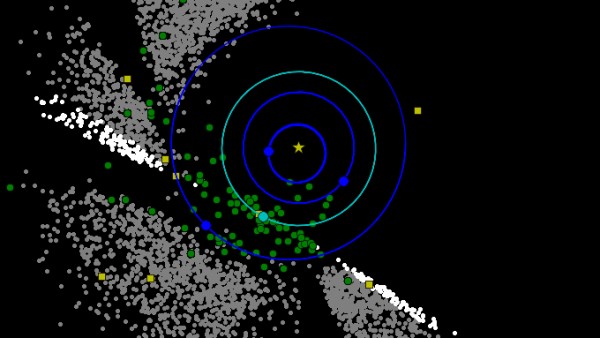By Ana Verayo, | April 08, 2016

This graphic shows asteroids and comets observed by NASA's Near-Earth Object Wide-field Survey Explorer (NEOWISE) mission
NASA scientists just released new findings from the NEOWISE mission revealing 439 near Earth objects that could be asteroids, meteors or space debris. The Near-Earth Object Wide-field Survey Explorer mission was launched in 2009 where the spacecraft aims to detect nearby comets and asteroids that can be potentially dangerous to Earth as they orbit around the sun within a short distance of the planet.
Like Us on Facebook
According to deputy principal investigator, James Bauer of NASA's Jet Propulsion Laboratory in California, when it comes to studying near Earth objects especially the distribution of lighter and darker colors of the NEO material, NEOWISE data provides a better understanding about the origins of NEOs which have been traced back to the different regions of the major asteroid belt located between Mars and Jupiter.
Scientists classify these space objects as near Earth objects depending on its distance from its orbit around the sun and Earth. More specifically, when the nearest approach of this object to the sun is less than 1.3 the distance between Earth and the sun.
The NEOWISE spacecraft is also the WISE (Wide-field Infrared Survey Explorer) probe that has been launched by the space agency in 2009. In February 2011, it has been placed in hibernation once its original mission was completed, which is to create infrared maps of the Earth's sky. In September 2013, it was known as NEOWISE for this new mission, which is to detect and identify new populations of potentially dangerous near Earth objects.
Beginning December 2013, this spacecraft has already found some 250 new asteroids and comets including 72 that are near Earth's backyard. In the past year, eight of these NEOs have been classified as potentially hazardous asteroids which refer to space objects that possess orbits that are in between Earth and a distance of 0.05 astronomical units or less than 4.65 million miles.
According to NEOWISE principal investigator, Amy Mainzer, NEOWISE also focuses on larger, darker near Earth objects that can help ground based telescopes that are working with visible light wavelengths. These near Earth objects can also measure up to hundreds of meters across on average.
Apart from this, NEOWISE has observed and investigated more than 19,000 asteroids and comets within infrared wavelengths.
-
Use of Coronavirus Pandemic Drones Raises Privacy Concerns: Drones Spread Fear, Local Officials Say

-
Coronavirus Hampers The Delivery Of Lockheed Martin F-35 Stealth Fighters For 2020

-
Instagram Speeds Up Plans to Add Account Memorialization Feature Due to COVID-19 Deaths

-
NASA: Perseverance Plans to Bring 'Mars Rock' to Earth in 2031

-
600 Dead And 3,000 In The Hospital as Iranians Believed Drinking High-Concentrations of Alcohol Can Cure The Coronavirus

-
600 Dead And 3,000 In The Hospital as Iranians Believed Drinking High-Concentrations of Alcohol Can Cure The Coronavirus

-
COVID-19: Doctors, Nurses Use Virtual Reality to Learn New Skills in Treating Coronavirus Patients







